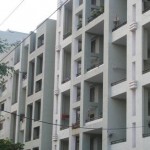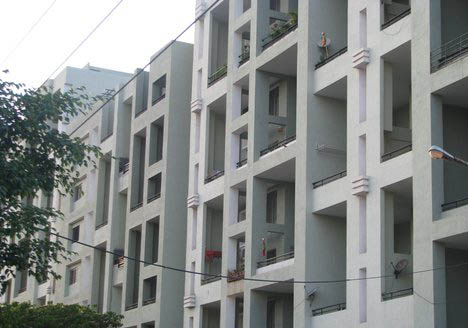By: Ravi Sinha
 Track2Realty Exclusive: Has populism been behind the Maharashtra Government notification on affordable housing is the question that everyone within the built environment of real estate is today asking. There is a general feeling among the developers that the Maharashtra Government notification for the builders developing a housing project on a 4,000 sq m (acre) plot to reserve 20 per cent of the area for affordable housing is not in sync with the market reality. The developers call it an unnecessary burden on them without any policy incentive; something that may lead to more negative sentiments in the market instead of addressing the issue of supply of EWS/LIC housing. Worse even, they demand clarity with this notification that needs to be addressed.
Track2Realty Exclusive: Has populism been behind the Maharashtra Government notification on affordable housing is the question that everyone within the built environment of real estate is today asking. There is a general feeling among the developers that the Maharashtra Government notification for the builders developing a housing project on a 4,000 sq m (acre) plot to reserve 20 per cent of the area for affordable housing is not in sync with the market reality. The developers call it an unnecessary burden on them without any policy incentive; something that may lead to more negative sentiments in the market instead of addressing the issue of supply of EWS/LIC housing. Worse even, they demand clarity with this notification that needs to be addressed.
The notification by the Maharashtra Government says that the developers must keep 20 per cent area for affordable housing. The developer will receive 20 per cent extra floor space index (FSI) as an incentive for the 20 per cent reservation for public housing. In principle the move is aimed at benefitting low income groups (LIG) and economically weaker sections (EWS), who will be allotted the 323-538 sq ft tenements through a lottery by MHADA, the state housing authority. The scheme will create more housing stock at a time when MHADA does not have much land with it here.
The notification says that when the developer intimates MHADA about granting of an occupation certificate (OC) by the planning or civic body to his newly built apartments, MHADA has to decide within six months if it will purchase the 20 per cent tenements or allot them to those selected through a lottery system. In case of plot, if MHADA declines to purchase it within six months, he can sell them in the open market, for which additional FSI will not be permissible.
In case of tenements, the developer or land owner has to sell plots of flats to MHADA or allottees selected by MHADA at construction rates decided by the inspector-general of registration, Pune, under annual statement of rates in the year of the scheme’s approval. The developer has to first get an OC for affordable housing, then only will he get an OC for the other 80 per cent housing, which he can sell in the open market at market rates.
The notification, however, leaves the developers with more questions than the government has the answers in hand. For instance, the clarification sought by the industry bodies question whether the plot potential to work 20 per cent EWS/LIG tenement should be considered after deduction of 15 per cent RG (Recreation Ground) area required as per Reg No. of 23 of DCR 1991.
In the proposals for redevelopment of existing buildings where or when the developer or society has come forward for redevelopment of the existing building with utilisation of TDR (Transfer of Development Rights) or additional FSI (Floor Space Index), the potential of the plot which is already developed to its full potential shall be considered after deduction of the existing built up area or otherwise.
Admitting confusion for the developers with this notification, Manju Yagnik, Vice Chairperson of Nahar Group questions that in case of proposals wherein the developer has already proposed the tenements having size 50 sq mtrs in area to the tune of minimum 20 per cent EWS/LIG, whether the provision would still be applicable over and above the already provided 20 per cent.
“In case of the redevelopment on MHADA land as per the Reg 33 (5) for Middle Income Group wherein the tenement size up to 80 sq mtrs that is required for rehabilitation of existing tenants and the 60 per cent tenements of the MHADA layout are within EWS/LIG/MIG category, whether the said provision of 20 per cent would still be applicable,” asks Yagnik.
Hariprakash Pandey, Vice-President, Finance & Investor Relations, HDIL agrees that there is a need for policy incentives for developers. According to him, some points in the notification are concerning as they could result in an increase in the construction costs for developers, as well as delay the approval process. In cases where the developer constructs and hands over LIG units to MHADA, he will be compensated as per the Ready Reckoner rates of Rs 1,600-1,750 per square foot, which is lower than actual construction cost of Rs 2,500-3,000 per square foot, resulting in a loss for the developer.
“The occupancy certificate for the free sale portion will not be granted till the OC for the LIG units is issued which could delay the construction of the project. Developers will now also need more time to amend the project designs as per the notification, which could further delay the projects by 4-6 months. As per the notification, MHADA has the option to buy the LIG flats within six months after the construction. Therefore the developer has to fund the expenses from his own pocket, unlike the free sale flats, which are built from the pre-booking amount collected at the time of booking the flats. The government should revise the notification ensuring that MHADA buys the flats well in advance or during the stage of construction itself,” says Pandey.
There are others who crib why as per the notification, the built up area of the EWS/LIG tenements constructed under the said scheme shall not be counted towards FSI. They also question whether the area of such tenements would be accounted for overall cap for utilisation of TDR and TDR component needs to be reduced to that extent or whether 20 per cent EWS/LIG built up area being free of FSI shall be over and above the cap of 2 FSI as stipulated in Reg. No. 32, table 14, amounting to an FSI of 2.2.
It is also not clear whether the said notification would be applicable in CRZ and NDZ area. Moreover, it is also not clear whether the 20 per cent area to be handed over to MHADA is inclusive of the areas which are exempted from computation in FSI by charging premium. Developers say they are also clueless that if it is not so, then whether the premium required to be paid for open space deficiency are exempted or not. In case of the composite building wherein 20 per cent tenements to be handed over to MHADA and sale area is proposed in single building whether the payment for all other charges should be recovered proportionately/exempted, if MHADA component is more than 50 per cent and treated as composite building.
In conclusion, the Maharashtra Government’s notification has created confusion among the developers and property analysts. There is a general feeling that the said notification is silent on the issues which can arise after grant of occupation. The policies for guidelines should be formulated for maintenance of common amenities, utilities and payment of property tax. A section of analysts feel that only if the issues are properly addressed by the government, this notification will be a good incentive for providing adequate affordable housing to the masses. Failing this, it may lead to policy ambiguity and hence defeating the purpose of affordable housing.





